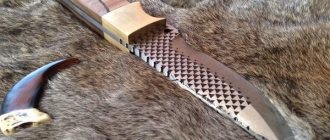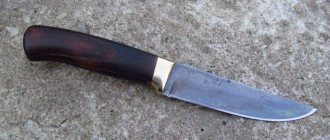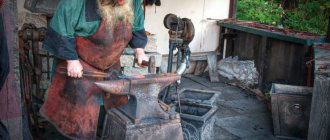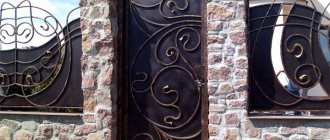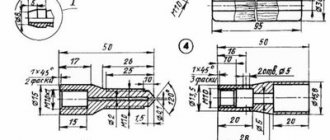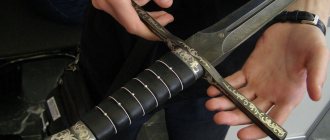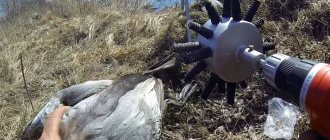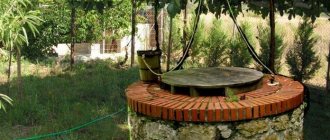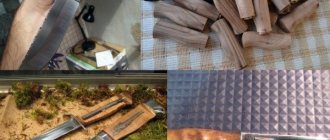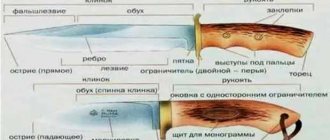What is a good knife
First, let's agree on the functional purpose of the knife that you are going to make with your own hands. Most likely, the best choice will be to focus on making a high-quality hunting knife. With hunting knives, we also need clarity: which one is the most versatile?
Experienced hunters may have substantial collections of hunting knives of varying sizes and quality, but they only go hunting with one.
Forging a knife from a rope.
He will be the most suitable. After analysis and surveys in hunting sources, a description of the average hunter’s knife appeared, which can be considered the most universal.
For Russian hunting conditions, this would be a knife of medium size with the following dimensions:
- The blade can be from 12 to 14 centimeters long, and no more than 3 cm wide.
- The thickness of the blade is approximately 3 - 4 mm.
- The total length of the knife ranges from 23 to 27 centimeters.
Product care
Features of care:
- After use, the blade must be wiped to remove any remaining moisture or dirt.
- It is important to learn how to sharpen a knife correctly. To do this, you need to use sharpening stones of different grits.
- Rust should be washed off with special chemicals.
- It is better to store the blade in a special case. It is important to protect it from moisture penetration.
Blacksmiths recommend sending blades to specialized workshops for resharpening. Only with professional equipment can you obtain high quality sharpening.
Knife forging is an ancient technological process for making edged weapons. With its help, blacksmiths create blades for hunting, fishing, cooking, etc. To save money, you can try to forge a knife from steel yourself.
Steel and only steel
The choice of metal is limited, or more precisely, you have no choice at all. Only steel for forging knives, no options. Let's figure out what steel is in principle: it is an alloy of iron and carbon. The typical carbon content range in steel is from 0.1% to 2.5%. The higher the level of its content, the stronger and more resistant the steel is to external influences, but it immediately loses its ductility and toughness.
Properties of steel that have the most direct impact on the good quality of the product:
- High wear resistance depends on the hardness of the steel, which in turn depends on the carbon content of the alloy.
- High strength – maintaining the integrity of the product under the influence of external forces.
- Hardness is its resistance to deformation.
- High ductility is the ability of a steel product to bend under the influence of external forces and then restore its shape.
- Red resistance is the resistance of a metal to high temperatures. Hard grades of steel are the most red-resistant.
Forging tools.
Blacksmith tool.
Knife forging diagram
Forging knife dimensions.
Relief surface on the blade.
It is important that all five indicators are closely interrelated. The more ductile the steel grade, for example, the lower its hardness. The properties of alloys can be controlled using additives and alloying elements.
Now about doping. This is the targeted addition of additives to metal to change various properties for the better. What steel is not alloyed with: nickel, molybdenum, cobalt, etc. We are interested in alloyed tool steel, which has the properties described above. There are many brands of high-quality metals; their characteristics can be found in numerous reference books and manuals.
It is enough for us to understand the general principles in order to find a suitable steel for our knife. You don’t need to go far to get it; a knife is forged from bearings, files, springs, drills and even metal cables. In each case there are technical nuances, but the general rules for forging knives at home are the same and strict.
Knife design and drawing
As mentioned above, first you should try to forge any unnecessary piece of iron more than once. And only then try to forge the simplest and most common form of a kitchen knife first.
Take this stage more seriously, don’t be afraid to draw on paper. “Estimate” how much metal you have; you should definitely take into account that a lot of it will go to waste and scale.
The Finnish blade is also quite simple in its design; you can choose it in the form of a “first-born”. They can also be used wonderfully in the kitchen or in other settings. And we guarantee you that if you succeed, the blade will become your favorite.
One rather important note: carefully study the characteristics of edged weapons, and be sure to adhere to certain rules when making them. It’s one thing to have a bladed weapon with you, but making one is quite another.
Or if you decide to give it to a loved one, then it will already be distributed and there will be an article for this, up to and including imprisonment. Be careful about this.
Drawing of a knife for forging.
Having drawn the future blade on a piece of paper, it may even be better to make a cardboard template out of it. You need to draw a drawing diagram, with the arrangement of all sizes and don’t forget about the handle. A template can be very useful when creating bevels, blades, and in general, the appearance of the product will be before your eyes.
Blade design, knife and law
Forging a knife from a chain.
This is not about beauty, but about the shape of the blade, which must be selected and sketched at the start of the preparatory work. There are few basic forms of blade profiles: dagger, straight spine, profiles with a raised or lowered spine line, finca or bowie, goat leg, tanto.
Let us immediately note that, for example, “tanto” or finka and “bowie” refer to bladed weapons.
Attention! Before choosing a blade shape, you need to carefully read about the characteristics of bladed weapons, so as not to end up under a criminal offense with the chosen shape. If carrying a bladed weapon is fined with a small sum of money, then for the manufacture and sale of bladed weapons you can get two years in prison.
Stages of preparing and making a knife
The process of making a knife is quite complicated - you will have to go through several stages from cutting and forging to grinding and sharpening. Here is a brief description of these stages:
It is best to take a drawing and template for a knife from specialists or from magazines, since the optimal shapes of knives have long been worked out;
blank - steel can be bought in the form of a finished piece, but in any case it will need to be broached to give the metal the required strength;
[cutting] and machining - this will have to be done with a milling cutter or an emery sharpener, carefully monitoring the heating so as not to spoil the metal;
hardening and tempering is a very difficult task, since it is necessary to precisely maintain the temperature, and only experienced craftsmen can do this visually.
At the last stage, the knife is assembled with the parts of the handle installed, which must be balanced and consistent in shape.
IMPORTANT TO KNOW: Bent channel - manufacturing and production features
Knife forging tools
What tools are needed for forging:
- large hammer up to 4 kg and small hammer up to 1 kg;
- anvil;
- welding machine and grinder;
- grinder;
- bake;
- pliers and an adjustable wrench.
Damascus steel knives.
Knife made of tool steel rod. Blade forging.
Forged knife blade. Decoration of a forged knife.
Artistic forging of knives.
A forged knife is a souvenir.
You can buy a stove, or you can make it yourself. The main requirement for such a stove is to obtain a temperature from 900° to 1200° for quite a long time. Thick sheet metal is best. A mandatory tube for air to enter the stove. You can heat the stove with regular charcoal.
Advantages and disadvantages
Forged knives have serious advantages over other types, it’s not for nothing that they prefer to take them on hikes and fishing. Main advantages:
- Strength - the products are forged from a single piece of steel, so they do not have connecting seams. As a result, the blade does not break off from the handle, and the knife itself is able to withstand the heaviest loads without compromising functionality.
- Attractive appearance – forged blades are most often made to order, so the design of each product is unique; many examples are considered real works of art. Particularly interesting examples are obtained when forging a knife with your own hands.
- Durability - the product will serve for decades without changing its original appearance.
- High-quality blade - thanks to a special manufacturing technology, the knife remains sharp for a long time, which cannot but please its owner.
- A special method of production - these products are made according to the principles that define blacksmithing, resulting in them being very durable and beautiful at the same time.
A pressed stamp on the blade, applied by impact, distinguishes a real forged knife from other analogues. Like any other product, a forged specimen has some disadvantages. Whether they can be called large-scale or critical is up to the user to decide.
The first disadvantage is the considerable weight of the steel product - it is difficult to get used to the knife after other, lighter tools, and it is constantly inconvenient to work with it. The disadvantages also include the high price.
It is impossible to find good hand-forged knives, the steel of which meets established standards and declared characteristics, in mass sales. Most of these products are made to order in special workshops and according to individual projects.
Manufacturing technology
Forged knives have a complex multi-stage production system, but it is thanks to this technology that it is possible to achieve excellent quality of each product. Four main manufacturing stages:
- Procurement of material - at this stage, the metal from which the master will forge a knife is selected. Experts prefer to use alloy tool steel grades, for example, ШХ15 or 9ХС. At this stage, a full-size sketch of the future work is also created so that the blacksmith understands how much material will be required.
- Heating and rough forging - so that the material can be worked with, it is heated to the required temperature. To do this, the steel is sent to a pre-prepared furnace for a certain amount of time; the duration of incandescence for each selected brand is different. The metal is then taken out and hammered to its original shape. It is important to take into account that after roughing the steel will begin to cool and settle, due to which the size of the workpiece will decrease by at least 1.5 times.
- Finish forging - at this stage the blade is given its final shape, the surface is decorated with ornaments or designs, and the blade is sharpened. After finishing forging a knife with your own hands, you will no longer be able to make any changes.
- Hardening - the last step is to lower the product into a cold environment, which is necessary to impart strength to the steel.
Water is usually used as a cold medium; in winter, snow is used. A suitable option would be to blow cold air over the tool.
Many novice blacksmiths forge knives at home, which means using professional equipment such as a forge, anvil, hammers, and tongs.
An improvised forge can be placed, for example, in a country house. The starting material can be bearings or a file, which are then melted into a blade.
If you wish and study the intricacies of the process, forging a knife with your own hands is quite possible, but such a hobby will require considerable financial investments.
Some workshops provide for a fee; the user makes the product independently, and each stage of the process is accompanied by the help and tips of a professional blacksmith.
Important selection criteria
Before purchasing a forged knife, you need to understand exactly what characteristics it must meet. There are several criteria that you should focus on. The most common ones are listed below.
Purpose of use
There are mainly three types of forged blades: hunting, kitchen and combat. Each has certain differences:
- Hunting knives are medium-sized, they have a large blade and a small handle. They are often decorated with additional ornaments or elements, such as a hook for skinning the animal. They are the ones that most often become collection items.
- Forged kitchen knives have a narrow scope of application; most often they are used in the process of preparing fish dishes. The products are especially popular among haute cuisine chefs, but sometimes they are also bought for home use (if the price and weight do not deter non-professional cooks). Such specimens are longer than hunting specimens and have a proportionate blade and handle.
- Combat knives are not sold en masse; you must have a service permit for them. But throwing blades are in great demand. They must be balanced, thin and light in order to accurately perform their intended function.
Knife from a drill, stages of work
How to properly make a knife from a drill:
A blacksmith creates a knife blank.
- We understand drills and steel . A drill is one of the most popular sources of steel for amateur blacksmiths. In fact, P6M5 steel, alloyed with tungsten and molybdenum, has excellent characteristics for a future cool knife: it is extremely durable, highly resistant to wear and is also easy to sharpen, which is especially important for knives. Similar steel on imported, excluding Chinese, drills is designated as HHS - High Speed Steel, steel for working at high speeds. The best option would be a drill made of steel, to which cobalt has been added in addition to tungsten and molybdenum; it is even more stable and is called R6M5K5. Well, imported drills will become HHS-Co in this case. So, remember: we are looking for domestic drills made of P5M5 with the addition of cobalt, or imported ones, excluding Chinese) HHS, also with the addition of Co. If you have a large drill in your hands, look at it carefully. They usually consist of two parts: a shank made of the most common steel and a working spiral made of the R6M5 steel we need. The boundary can be determined by sparks when turning a drill along its length. The sparkle on a section of alloy steel will be reddish and sparse. On a section of ordinary steel, the sparks will come out yellow and the sheaf will be large.
- Steel firing . This is a simple and “calm” stage of work. You need to light the oven and heat the workpiece in it to about 600° - 700°, maintain this mode for about four hours, then let the stove cool down along with the workpiece. Attention! This stage is not described in many sources and manuals. Why do this? The fact is that most artisan craftsmen make knives from ready-made and hardened tools. Firing them is necessary precisely in such cases, otherwise during further forging, unnecessary stress may arise in the metal structure. For reference: a temperature of 700° can be easily checked using salt - at this temperature it begins to melt.
- Warming up the drill . We flood the stove with air supply, after heating the coals, place the drill in the stove using pliers. If you are forging a knife for the first time, you may make a mistake in determining the heating temperature - either overheat or underheat. In any case, the heating temperature should be above 1000° with an orange color of the workpiece. Immediately the drill is removed from the stove and the shank is clamped in a vice. The very first and most urgent thing is to straighten the drill spiral by clamping the tip with an adjustable wrench. If you do not have time to untwist the spiral, the drill may break. If the spiral does not unwind in one go, you can heat the drill again. As a result, you need to get an even strip of steel.
- Forging and rolling . We heat the steel strip again and begin to level it with blows of a heavy hammer. As a result, the strip should become wider and thinner: from 4 to 5 mm. Forging a knife means constant control of the color of the steel strip. If it begins to fade and cherry shades appear, immediately put it in the oven to heat up again.
- Attention! The main rule of the stove: it is better to overheat and even overheat than to break a cooled product with hammer blows. To help blacksmiths, there is a special scale of temperatures and colors of steel. If at low temperatures of 500° - 600° the steel will be dark brown, then at 1000° the steel will turn orange. Well, at the highest heating up to 1300° it will become dazzling white.
- Forging the blade tip . One of the most difficult stages is essentially the forging of a knife. The blade needs to be given the desired shape without changing the thickness - you have already achieved the desired thickness of 4 - 5 mm in the previous stages. Some practice is needed here: the tip needs to be gradually rounded, and the blade must be simultaneously pulled out in length. This job may not work out the first time, be prepared for such a situation. You have a personal quality called “patience,” right?
- Forging the cutting edge . This is also a difficult and important stage. It is performed with a small hammer: with careful blows, the cutting edge is made as thin as possible, starting from the middle of the blade. The blade should remain straight. At this stage, heating the workpiece is also extremely important: monitor the color and, if necessary, heat it in the stove.
- Shank forging . Everything is much simpler here. Heat the shank in the oven and roll it out with a large hammer. The shape will depend on your choice of handle design, which is not covered in this review.
- Grinding . A rewarding and enjoyable job: removing excess layers and unevenness, leveling the surface to a shiny state is a pleasure. It should be remembered that when grinding the thickness will decrease, up to 2 mm may be lost. As a result, the knife will become lighter and thinner. Sharpening is also done at this stage.
- Knife hardening . Do not neglect this stage under any circumstances, despite the fact that your knife looks great and seems completely ready for use. The main working properties of the knife will depend on hardening. After grinding and complete cooling, the knife is heated in the oven until it turns orange or light red, the temperature is approximately 500° - 700°. Then it is quickly dipped into salted water or oil. In water, the steel begins to “tremble” - this is the hardening process. Some perform another operation “on the path”: they release the blade. Vacation consists of a slight final heating until a thin orange film appears: immediately remove the knife from the stove and let it cool on its own.
How to forge a blade from a file
For forging you will need a standard blacksmith's set: a forge, an anvil, a pair of hammers (one 1.5-2 kg, and one 0.3-0.5 kg), pliers, a metal brush.
Preparation of material
When making a knife from a file using the blacksmith method, the first thing you need to do is burn the steel. The procedure is done as follows.
- Light a fire in a stove (not gas!) and place the workpiece in the hearth.
- Keep the metal on fire for about 4-5 hours.
- Allow the workpiece to cool along with the oven.
This is done in order to release the metal, since in tools it is additionally hardened and, if this is not done, stress will arise in the structure during forging.
The firing temperature should be 600-700 degrees. They check it by sprinkling the workpiece with salt: if it melts, it means the process is going correctly. It is important that the metal heats up evenly along its entire length (the same uniform color).
After firing, the combustion temperature must be reduced gradually, and then the workpiece should be left in the smoldering coals until it cools completely (about a day). If you cool a heated metal very quickly, it can simply crack or even crumble.
Knives made of files, springs, cables, bearings
Features of workpiece processing:
Creating a workpiece in a blacksmith's workshop.
- Nuances with the bearing . Very popular material. Usually the inner rim of the bearing is used. The work is almost the same as with a drill. The only difference is the inconvenience at the first stages: the rim blank is very inconvenient to hold, so it is better to weld it to the reinforcement rod. It is easier to forge a steel strip than from a drill - here it is enough to level it.
- Car spring . Excellent material with high elasticity and wear resistance. We cut the workpiece with a grinder, weld it to the reinforcement rod in the same way as a bearing rim - in this case it is much more comfortable to work.
- A file is the second most popular type of available material for high-end knives. Features of steel in files are rare durability and excellent cutting edge. The nuances of working with a file include the obligatory cleaning of the file surface from notches using a grinder.
- Knives made of metal cable. The option is quite rare. The steel in the cables does not meet all the requirements for a good knife. Most often, such knives are made because of the remaining pattern on the blade, which resembles Damascus steel. This kind of production is often carried out by swindlers in order to sell low-quality knives, similar to the famous Damascus knives, to amateurs. Forging a knife from cable is a complex process that is unlikely to be suitable as a debut for beginners.
Forging a knife with your own hands is a very interesting activity that will bring you serious practical benefits, aesthetic pleasure and increased self-esteem. Chances are you won't stop at just one knife. There are no limits to perfection anywhere, and even more so in blacksmithing. We wish you good metal, a hot stove and good friends!
What metal is best to make a knife from?
Several types of steel are suitable for making and forging knives. It is worth considering it by grade to determine its suitability for a particular task.
Steel 95Х18
High strength knife steel with high corrosion resistance. It is characterized by an optimal ratio of hardness and strength, which allows you to make a hunting or kitchen knife with an edge protected from chipping. Hardness index 64 - 62 HRC depending on the heat treatment of the material.
Steel 50Х14 MF
Tool stainless steel with a hardness rating of 58 HRC, which is used in the manufacture of scalpels. Knives made from it do not become dull for a long time. Sensitive to contact with bones and hard surfaces.
Steel X12MF
Die steel that can be hardened to 62 HRC. It is characterized by high impact strength and sensitivity to corrosion; it is not suitable for hunting and tourist knives, as it requires careful care.
Steel HVG
Tool material with average hardness and good impact toughness. Holds loads well.
Steel 50 HGA
A spring metal that can withstand loads well, but is prone to corrosion.
Steel 40Х13
Spring stainless steel, the knife from which will be beautiful, but with a fragile cutting edge. Suitable for the kitchen due to its flexibility and sharpening, but not for cleavers, camping and hunting knives.
Shutdown
Let the metal cool and start grinding. For this you will need a grinding machine. Remove uneven surfaces and excess metal. A forged knife should be shiny and perfectly smooth. The grinding process usually removes 1-2 mm of thickness, so after processing the knife will become noticeably thinner and lighter. At this stage the leg is sharpened. Finally, it is hardened.
https://moyakovka.ru/youtu.be/a3-TDGxvxlU
Hardening a knife begins with heating it to an orange color. After this, it is lowered into oil or water. Add 3 tablespoons of salt per 1 liter to the water. The oil should have a temperature of about 25-30 degrees, and the water - up to 25 degrees. After hardening, the blade is released.
To do this, you need to hold the knife over the flame and monitor its changes. Immediately after the surface of the knife is covered with a yellow-orange film, the knife must be removed from the fire and allowed to cool. Good luck!
